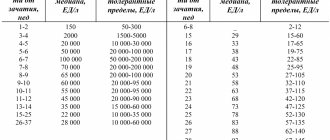Views - 109,724
The embryo and the membranes surrounding it are the main initial components of the amniotic egg. As the fetus develops, the space around it also increases - this is a normal process of embryo development. Next, you are invited to familiarize yourself with key information directly about the fertilized egg, as well as regarding the peculiarities of changes in its size during pregnancy and possible pathologies of formation.
- Features of the growth of the fertilized egg
- Possible developmental disorders of the ovum
Video - Size of fertilized egg by week of pregnancy table
Ultrasound diagnosis of short term pregnancy
In early pregnancy, an ultrasound is performed to identify a viable embryo in the uterine cavity, confirm the gestational age, exclude pathology of the embryo, or identify normal variants, such as multiple pregnancies.
The initial sign of pregnancy is thickening of the endometrium, but ultrasound does not tell what exactly causes this thickening.
Using a high-resolution transvaginal transducer, a gestational sac with a diameter of 1 mm is visualized in the uterine cavity 4 weeks and 2 days after the last menstrual period during a regular menstrual cycle.
Fertilization of the egg
If menstruation is delayed for 5-7 days or more (gestational age is 5 weeks), a fertilized egg with a diameter of 6 mm should be clearly visible in the uterine cavity.
It has a clear round shape with an indistinct light rim along the periphery (hyperechoic rim - chorion). In this case, the level of beta-hCG in the blood is 1000-1500 IU/l.
When the hCG level is more than 1500 IU/l, the fertilized egg in the uterine cavity should be clearly visualized.
Uterine pregnancy 4-5 weeks. Transabdominal scanning. IMPORTANT:
The gestational age cannot be accurately determined by the size of the fertilized egg.
Many tables on the Internet with the size of the fertilized egg determine the period very approximately.
From about 5.5 weeks, transvaginal ultrasound begins to visualize an extraembryonic structure in the fetal egg - the yolk sac (eng. yolk sac). At the same time, the beta-hCG level averages approximately 7200 IU/l.
Since the yolk sac is part of the embryonic structures, its detection makes it possible to distinguish a fertilized egg from a simple accumulation of fluid in the uterine cavity between the endometrial layers, and in most cases, makes it possible to exclude an ectopic pregnancy.
The incidence of ectopic pregnancy is 1-2 in 2000–3000 pregnancies. Its risk increases with the use of assisted reproductive technologies (ART).
It is necessary to suspect an ectopic pregnancy when the hCG level is more than 1500 IU/l, and the fertilized egg is not detected in the uterine cavity.
Pregnancy 5.5 weeks. The yolk sac is identified. Transvaginal scan.
From 6 weeks of pregnancy (sometimes a little earlier), an embryo about 3 mm long can be identified in the fertilized egg.
From this same period, most ultrasound machines can detect the heartbeat of the embryo. If the heartbeat is not detected or is unclear when the embryo length (CTE) is 5 mm, a repeat ultrasound scan is indicated after a week.
The absence of cardiac activity at this stage is not necessarily a sign of fetal distress or a non-developing pregnancy.
The numerical values of the heart rate in an embryo during an uncomplicated pregnancy gradually increase from 110-130 beats/min at 6-8 weeks of pregnancy to 180 beats/min at 9-10 weeks.
The length of the embryo is measured from the head to the tail end, and is designated under the term CTP (coccygeal-parietal size), in English. literature - CRL (Crown-Rump Length).
It should be noted that the coccygeal-parietal size of the embryo is less subject to individual fluctuations than the average internal diameter of the ovum, and therefore, its use to determine the gestational age gives better results. The error usually does not exceed ±3 days.
With clear visualization of the embryo, the gestational age is determined depending on its length, and not on the size of the average internal diameter of the ovum (SVD).
To correctly measure the coccygeal-parietal size of the embryo, its clear visualization is necessary. In this case, one should strive to measure the maximum length of the embryo from its head end to the tailbone.
Normal pregnancy
During normal pregnancy, the diameter of the ovum increases by 1 mm per day. Lower growth rates are a poor prognostic sign. With a gestation period of 6-7 weeks, the diameter of the ovum should be about 30 mm.
It should be emphasized that determining the gestational age by the length of the CTE is best done before 12 weeks of pregnancy. At a later date, measurements of biparietal diameter, head and abdominal circumference should be used.
The motor activity of the embryo is determined after 7 weeks of pregnancy. At first, these movements are very weak and isolated, barely noticeable during examination.
Then, when differentiation into the head and pelvic ends of the embryo becomes possible, movements resemble flexion and extension of the torso, then separate movements of the limbs appear.
Since episodes of motor activity of the embryo are very short and count in seconds, and periods of motor rest can be significant in time, recording the cardiac activity of the embryo is undoubtedly a more important criterion for assessing its vital activity.
Non-developing pregnancy
The diagnosis of a non-developing pregnancy should not be made if, on ultrasound, the ovum is less than 20 mm in size. When the embryo is 5 mm or more in length, in most cases the heartbeat should be clearly detectable.
If the embryo is less than 5 mm, the ultrasound should be repeated after a week. If, upon repeated examination a week later, at CTE = 5-6 mm, cardiac activity is not detected, the pregnancy is not viable.
The diagnosis of a non-developing pregnancy can be confirmed by a discrepancy between the beta-hCG level and echographic data.
It should be noted that the normal rate of pregnancy termination in the population is 15-20% of all clinically diagnosed pregnancies. However, in reality, if we consider all “chemically” diagnosed pregnancies, determined by the level of beta-hCG before the expected next menstruation, the rate of miscarriages can reach up to 60%. Successive stages of fetal development in the uterine cavity and the establishment of the “mother-fetus” system
Original article on the website dr-ermakova.ru
Author of the text: Barto Ruslan Aleksandrovich
Source: https://zen.yandex.ru/media/dr_ermakova/ultrazvukovaia-diagnostika-beremennosti-malogo-sroka-5e4366d7d877b06d5336b57b
Formation and emergence of the fetus
The formation of an embryo is based on active division at the cellular level.
The cells of the embryo grow, due to which the size increases. The process continues for 6-7 days, as it moves along the fallopian tube to the uterine cavity, where implantation will occur. Initially, nutrition occurs through independent resources. After attachment, nutrients flow through the uterus, at the same time the placenta begins to form for further protection and breathing of the child. At 4-5 weeks, using ultrasound, you can see a round shape, which reaches about 4 mm in diameter. And only at the beginning of the second month of intrauterine development, the formed baby becomes noticeable on the ultrasound monitor. Due to various anomalies, the absence of an embryo can be diagnosed when the embryo, for various reasons, has not formed. After a certain period of time, a second study is prescribed to confirm the diagnosis by the heartbeat, which occurs in the middle of the second month. The fetometric indicator SVD evaluates the diameter and can vary when determining the gestation period within 10 days. Therefore, to determine the period, it is necessary to take into account additional parameters.
Size of the ovum by week of pregnancy - table, development, pathologies
The embryo and the membranes surrounding it are the main initial components of the amniotic egg. As the fetus develops, the space around it also increases - this is a normal process of embryo development.
Next, you are invited to familiarize yourself with key information directly about the fertilized egg, as well as regarding the peculiarities of changes in its size during pregnancy and possible pathologies of formation.
Basic information about the fertilized egg
As you know, fertilization occurs through the penetration of a male sperm into a female egg. After this, the active process of embryo development begins: first, the fertilized egg is divided into 2 parts, then into 4, then into 8, etc.
As the number of cells increases, the embryo itself grows. Without stopping to develop, the embryo moves towards its destination, which is normally the cavity of the female uterus. It is the mentioned group of cells that represents the fertilized egg in question.
Once the desired location is reached, the embryo is implanted into the wall of the uterus. On average, this process takes up to 7-10 days after the sperm penetrates the egg. Until reaching its destination, nutrition of the fertilized egg is provided directly by the egg, and after consolidation, by the uterine mucosa.
Over time, the functions of providing nutrition to the embryo are taken over by the placenta, which is formed from the outer layer of the fertilized egg. Directly on the mentioned outer layer there are so-called. villi, which ensure implantation of the embryo in a suitable place.
The formation and successful consolidation of the fertilized egg is the main sign of the normal course of female pregnancy.
On average, the embryo becomes visible during ultrasound examination 5 weeks after the missed period, while the fertilized egg can usually be seen after 2 weeks.
If during the first ultrasound the doctor sees the so-called. empty ovum, after a couple of weeks the test is repeated.
Normally, the embryo is visualized by the 6-7th week of pregnancy. During the same period, his heartbeat is usually noticeable. If there is no embryo in the ovum during repeated ultrasound examination, a non-developing pregnancy is diagnosed.
In view of this, if menstruation is delayed, a woman should have an ultrasound scan as early as possible in order to promptly detect existing abnormalities and, if such a possibility is present, undergo treatment to eliminate the identified problems.
When assessing the condition of the ovum, the specialist first of all pays attention to its shape and internal diameter. During the first weeks, the shape of the fertilized egg is close to oval. By assessing the internal diameter, the doctor can draw conclusions about the estimated gestational age.
Along with this, not every woman’s fertilized egg has the same size, so when determining the gestational age, an error often occurs, averaging one and a half weeks.
For more accurate results, fetal CTE and other diagnostic measures are assessed.
Features of the growth of the fertilized egg
As noted, the size of the fertilized egg, in the absence of various kinds of pathologies, is constantly increasing.
- For example, at a period of up to 5-6 weeks (on average 4), its diameter is about 4 mm.
- At a period of 5 weeks, the internal diameter of the fetal egg is 6 mm, and after 3 days it usually increases to 7 mm.
- At a period of 6 weeks, the dimensions are already more significant - in some cases, up to 18 mm (on average - 11-15 mm).
- The internal diameter of the fetal egg increases to 20-25 mm by 7-8 weeks, by 8-9 – to 28-33 mm, and by 9-10 – to 34-42 mm.
- By the end of the 10th week, the size of the fertilized egg is already approximately 5 cm.
- In general, answering the question about the growth rate of the fertilized egg, we can come to the conclusion that by 15-16 weeks of pregnancy it grows by an average of 1 mm daily, and after that it grows by 2-2.5 mm per day.
More detailed weekly information regarding the normal size of the gestational sac is given in the following table.
Table. Sizes of fertilized egg by week
Possible developmental disorders of the ovum
Under the influence of certain factors, the development of the fertilized egg can occur with certain pathologies. You can find a description of the most commonly diagnosed anomalies in the following table.
Table. Pathologies of the development of the ovum
PathologiesDescription
| Form violations | The shape of the fertilized egg in both scans up to 5-6 weeks is usually round. By 6-7 weeks, the fetal egg becomes oval in a longitudinal scan, but remains round in a transverse scan. Along with this, the development of form can occur with various kinds of deviations. Most often, this is caused by various types of tumors in the uterine cavity. Also, this pathology can occur in the case of partial placental abruption. |
| Pathologies of location | In the absence of deviations, implantation of the fertilized egg most often occurs in the fundus of the uterus or its posterior wall, sometimes in the area of the internal os or at the top of the uterus. Other options for the location of the ovum are assessed by a specialist. He also makes a decision on further actions in relation to a particular patient. |
| Dimensional violations | Information regarding changes in the size of the ovum as pregnancy progresses has been provided previously. Significant deviations from the given values in both directions are considered pathological, and conclusions about their significance are made by a specialist. |
| Functional pathologies |
It is impossible to give any definite answer regarding the causes of the development and treatment of pathologies in the development of the ovum - each case requires individual consideration by a qualified specialist. Only a doctor can objectively assess the situation and make the most appropriate decision.
Regularly undergo the necessary examinations, follow the recommendations of your treating specialist and be healthy!
– Size of fertilized egg by week of pregnancy table
If you liked it, please share with your friends.
Source: https://moy-kroha.info/razmer-plodnogo-yajtsa-po-nedelyam-beremennosti-tablitsa-razvitie-patologii/
Nine weeks
This time period is characterized by the size of the fertilized egg from 35 to 43 millimeters. In this case, it is already possible to detect the heartbeat of the embryo, which also, to some extent, makes it possible to more accurately determine the gestational age.
- 35 mm corresponds to 9 weeks exactly;
- 36 or 37 mm – 9 weeks. + 1 day;
- 38 mm – 9 weeks. + 2 days;
- 39 mm – 9 weeks. + 3 days;
- 40 or 41 mm – 9 weeks. + 4 days;
- 42 mm – 9 weeks. + 5 days;
- 43 mm – 9 weeks. + 6 days.
Fertilized egg - sizes by week
The shape, structure and size of the fertilized egg by week make it possible to clarify the nature of the course of pregnancy. To determine the values, an ultrasound is performed; if the values differ greatly from the norm, additional studies are prescribed to identify possible pathologies.
The fertilized egg helps to understand the nature of pregnancy
Features of the growth and structure of the fertilized egg
The amniotic egg is formed at the moment of fusion of the sperm and the egg; it initially consists of an embryo and a membrane; as the fetus grows, the structure of formation becomes more complex and the volume increases.
The main tasks are to provide the embryo with nutrients, support blood circulation at the initial stage of development, create the basis for the formation of the placenta, secure the fetus in the uterine cavity, and synthesize the hormone hCG.
Stages of formation:
- 7 days after conception, the chorion is formed - the outer dense shell of the embryo, through which oxygen and all useful substances are supplied to the embryo, protecting against infection. As pregnancy progresses, the chorion transforms into the placenta.
- There are many villi located on the surface of the chorion; they help the fertilized egg to gain a foothold in the uterus.
- Gradually, the hairs fall off, remaining only at the site of attachment of the egg to the uterus, the rest of the surface of the chorion becomes smooth.
- On the 20th day after menstruation, the yolk sac is formed - it performs the functions of the liver, kidneys, spleen, the first germ cells, blood cells, and blood vessels are formed in it. The absence of such a sac is a sign of pregnancy pathology.
- Inside the membrane that surrounds the embryo is the amnion, which produces amniotic fluid.
A small round or oval area is the fertilized egg.
Dimensions of the fertilized egg - norms by week
The size of the fertilized egg depends on the gestational age. In the absence of pathological processes, the diameter of the egg increases every day up to 15-16 obstetric weeks by 1 mm, and then by 2-2.5 mm daily. There are certain norms of indicators that allow one to judge the nature of the course of pregnancy; during an ultrasound, the thickness of the chorion is also determined.
Table of the size of the fertilized egg and the thickness of the chorion
| Gestation period (week) | Diameter of embryonic egg (mm) | Chorion thickness (mm) |
| 5 | 5 | — |
| 6 | 10,9–18,1 | — |
| 7-8 | 20,1–25,1 | 7–14 |
| 8–9 | 27,9–33,2 | 8–15 |
| 9–10 | 34,1–42,2 | 8,5-9,5–16,5–1,5 |
| 11 | 50 | 10–18,5 |
| 12 | 56-62 | 11,5-19 |
| 13 | 62–67 | 12,5–20 |
Possible pathologies
In the presence of unfavorable factors, the shape and size of the formation with the embryo change, which indicates pathological processes that can cause miscarriage and developmental abnormalities.
Possible pathologies may be detected in the image of the ovum
Pathologies and possible causes
| Pathology | Possible reasons | Provoking factors |
| Small fertilized egg | Frozen pregnancy, fetal development abnormalities. | Taking antibiotics, infections, genetic pathologies, hormonal imbalance. |
| Large fertilized egg | Death of the embryo, chromosomal pathologies. | Infections of the genitourinary system, gene pathologies, deficiency of sex hormones. |
| The egg shell is uneven and has corners | Hypertonicity of the uterus, if the cervix is closed and there is no dark vaginal discharge, then this condition is not considered dangerous, but requires constant medical supervision. | Low progesterone levels, high levels of male hormones, prolactin, endometriosis, fibroids, polyhydramnios. |
| Flat shape | Frozen pregnancy. | Hormonal imbalance, genetic abnormalities in the fetus, addictions, acute infectious diseases. |
| The amniotic sac is located very low | This arrangement is not dangerous, but requires constant medical supervision. If the egg has attached very close to the cervix, there is a high probability of developing cervical pregnancy; with such a pathology, removal of the uterus is often required. | Pathological changes in the mucous layer of the uterus, structural features of the amniotic egg. |
| The amniotic sac is empty, the embryo is not visualized | Ectopic or frozen pregnancy. | Genetic abnormalities, infections, endometriosis, endocrine and hormonal disorders. |
| Two fertilized eggs, one empty | The problem arises when conceiving twins, when the development of one fetus has stopped for some reason. The empty egg gradually dissolves on its own. | |
| Elongated shape | In the absence of other negative symptoms, the condition is not considered dangerous. | Severe stress, infectious pathologies of the genitourinary system, viral and bacterial diseases, hormonal imbalance. |
Thickening of the chorion occurs in diabetes, with the development of hemolytic pathologies, thinning is a sign of placental insufficiency. During inflammatory processes, a chorionic cyst is formed, and the blood supply in some areas of the membrane is disrupted. If the structure of the chorion becomes heterogeneous, hypoplasia develops, and the risk of detachment of the fertilized egg is very high.
If the size of the egg does not correspond to the gestational age, a repeat examination is required; often errors can be caused by an incorrectly determined gestational age.
How to detect anomalies?
The correspondence of the size and other parameters of the amniotic sac, the weight and height of the fetus are determined using different types of ultrasound; during a conventional examination, a two-dimensional picture appears on the monitor, and with echoscopy, a three-dimensional image appears.
- The transabdominal research method is carried out externally, the sensor is applied to the abdomen, and allows you to see the formation of the embryo at the 5th week of pregnancy.
- Transvaginal method - the sensor is inserted directly into the vagina; with this type of ultrasound, the size of the amniotic egg can be determined already 3-6 days after a missed period.
To determine how correctly the embryo is developing, during an ultrasound, not only the average internal diameter of the fetal egg (AVD) is taken into account, but CTR is the coccygeal-parietal size of the fetus, the distance from the highest point of the crown to the lowest point of the coccyx; normally, the length should increase by at least 0.7 mm every week. Measurements are taken until 12–14 weeks of pregnancy.
CTE allows you to find out the likelihood of developing chromosomal abnormalities in the fetus in the early stages of pregnancy; if there are deviations from the norm, an additional blood test and amniotic fluid must be performed.
During a miscarriage, the fertilized egg may fall out
If a miscarriage occurs, the fertilized egg is released, after termination of pregnancy a histological examination of the tissue is carried out, and if chorionic villi are present, a frozen pregnancy is diagnosed. The study allows us to exclude hydatidiform mole - malignant degeneration of cells.
Any ultrasound method is absolutely safe for mother and child. The first months of pregnancy are very important, all organs and systems of the fetus are formed, expectant mothers need to have an ultrasound done in a timely manner. The study allows you to determine the size of the embryo, accurately determine the gestational age, and identify possible pathologies during pregnancy or in fetal development.
Find out more on the topic: Pregnancy
Source: https://lechusdoma.ru/plodnoe-jajco/
Useful video about ultrasound in early pregnancy
After the fusion of the sperm with the female reproductive cell, the resulting zygote moves towards the uterus. After 24 hours, the fragmentation process begins, leading to the formation of a blastocyst consisting of approximately 100 cells on the 5th day. On the 8th day, the blastocyst penetrates the uterine endometrium.
The fetal tissues begin to produce human chorionic gonadotropin (hCG), and the formation of the fertilized egg begins. 14 days after ovulation, when menstruation should begin, there is no discharge - their delay indicates pregnancy (see also: what kind of discharge can there be in early pregnancy before menstruation is delayed?).
Norms for the size of the fertilized egg by week of pregnancy
The size of the ovum by week is a very important indicator during pregnancy.
When a woman realizes that she has a delay in menstruation, a pregnancy test gave a positive result, or she was tested for hCG levels, she goes to the antenatal clinic to confirm her situation and register.
Usually, the gynecologist gives a referral for an ultrasound, with the help of which the doctor determines the presence of a fetal egg, their number (whether the pregnancy is multiple), excludes anembryony (absence of an embryo in the fertilized egg), and assesses the size of the formation. An ultrasound is also necessary to determine whether a pregnancy is intrauterine or ectopic.
What is a fertilized sac?
Pregnancy begins with the connection of 2 cells - male and female. At this moment conception occurs. Afterwards, a very active and rapid increase in the number of cells begins in geometric progression. This entire constantly growing group of cells is called the fertilized egg. It becomes a formation around the developing embryo and contains amniotic fluid.
At a period of about 6 weeks, an ultrasound can observe the yolk sac, which is an important formation for the embryo, providing its nutrition and performing a hematopoietic function. Its absence can be dangerous for the embryo. The fertilized egg is visualized on an ultrasound machine as early as 2 weeks after a missed period.
The correct shape of the fertilized egg is also assessed, since defects may indicate congenital defects. Another important point is to avoid detachment. If abruption is confirmed, inpatient pregnancy maintenance and hormonal medications to support it are prescribed.
Therefore, it is very important to do an ultrasound on time.
On ultrasound examination, the formation looks like a small oval pea. Until the 5th week, it is almost impossible to see the embryo in the formation; it is clearly visible at about 6-7 weeks. At this stage, you can already hear the heartbeat of your unborn baby.
It is not yet possible to examine the embryo itself, since it is very tiny, like a small stripe.
Unfortunately, if up to 7-8 weeks several ultrasounds failed to see the embryo in the fertilized egg, the heartbeat is not heard, then there is a high probability that the pregnancy has frozen and the embryo is not developing.
Sizes by week
Measuring the gestational sac allows you to determine your due date. A value of 5-6 mm corresponds to about 5 weeks of pregnancy. However, thanks to modern transvaginal ultrasound devices, it is possible to detect a fertilized egg even with parameters starting from 1 mm.
The table, which shows the sizes by week, will help you find out about the standards.
At week 6, the parameters are 11 mm in diameter. At 7 weeks the diameter increases to 19 mm, at 8 - 27 mm, 9 - 35 mm, 10 - 44 mm.
However, it is impossible to call the correspondence of terms and sizes correct with complete confidence, since the size of the fetal formation may exceed or, conversely, be less than generally accepted norms, and this is completely normal.
After all, every woman has her own body characteristics and menstrual cycle. Each embryo is also individual. There are only average values indicating that the size of the fertilized egg should increase by 1 mm per day.
An embryo is considered a fertilized egg only up to 12-14 weeks from conception, since then the next stage of pregnancy begins, when the embryo becomes a fetus.
Disorders and pathologies
- Wrong shape. The correct fertilized egg is oval in shape. A round shape may mean congenital developmental pathologies in the unborn fetus. The cause may also be chorionic detachment, which manifests itself as nagging pain in the expectant mother.
- Wrong location.
The natural place is considered to be the attachment of the fertilized egg at the top of the uterus, on its bottom or back wall. The location in the cervix of the uterus is also considered normal. The remaining attachment sites are outside the normal range. - Deviation from parameters.
Although the average internal diameter has a wide range of fluctuations in standard values, deviations from this range can be dangerous violations. KTE has strict values, deviations from which are unacceptable and dangerous.
An empty and deformed fertilized egg is also considered a violation.
With anembryony, the fertilized egg is present, but the embryo is absent. At some stage, it simply stopped developing, which is why such a pregnancy is called a frozen pregnancy. If the embryo is not detected by ultrasound before 7-8 weeks, then the doctors make this verdict.
This happens because cells stop dividing. But the structure itself can continue to grow, albeit more slowly. Symptoms of pregnancy, such as toxicosis, can continue even with anembryonia.
If the egg is uneven and irregularly shaped, this may indicate a threat of miscarriage.
A woman must remain in bed for some time, not make sudden movements, take medications that relieve tone from the uterus, and progesterone is prescribed to maintain pregnancy.
In addition to the threat, this may be a sign of developmental defects, so additional studies are prescribed.
But do not forget that a specialist can make a mistake. Do not make hasty conclusions and contact several more ultrasound specialists.
What are SVD and KTR?
SVD and KTR are the most important measuring indicators up to 12-14 weeks of pregnancy. It is by them that it is determined whether everything is okay with the embryo and whether there is a risk of developing pathologies and birth defects.
SVD is the average internal diameter of the fertilized sac. The unit of measurement is millimeter. An error in setting the period of up to 1.5 weeks is acceptable, as it may depend on individual characteristics.
KTP is the coccyx-parietal size. The unit of measurement is similar. Errors in determining the period are not allowed; this is a more accurate indicator than SVD. The error may be no more than 3 days. CTE has an advantage over SVD in accuracy; it is measured after 5 weeks, when the embryo is visible.
Tables of ovum sizes by week of pregnancy can help the expectant mother obtain information.
Source: https://MoePuziko.ru/beremennost/techenie/razmer-plodnogo-yajca-po-nedelyam.html
Fetal development period: 5 weeks
What should be the size of the fertilized egg in this case? 5 weeks are characterized by an average internal diameter of 6 to 10 millimeters. In this case, good equipment and a competent specialist can determine the exact number of days. So, what is the size of the fertilized egg by week and day?
- 6 or 7 millimeters corresponds to a period of 5 weeks and 3 days;
- 8 millimeters corresponds to a period of 5 weeks and 4 days;
- 9 millimeters corresponds to a period of 5 weeks and 5 days;
- 10 millimeters corresponds to a period of 5 weeks and 6 days.
Fertilized sac on ultrasound: SVD sizes by week
What is SVD during pregnancy and how to determine it on ultrasound? There is only one answer to this question.
Fertilized egg illustration
The gestation period is characterized by certain values of the internal diameter. The digital value of the SVD constantly varies, so the period is calculated with an error of a week to a week and a half.
A more reliable sign for clarifying the gestational age using ultrasound is the CTR (coccygeal-parietal size) indicators.
It should be noted that the coccygeal-parietal size of the embryo is less subject to individual fluctuations compared to the average internal diameter of the ovum, and therefore is used more often to establish a reliable gestation period. The error is approximately three days.
When the fetus is well visualized, the period is determined by the length of the fetus, and not by the internal diameter.
The coccygeal-parietal size is recorded during a routine ultrasound and reflects the actual size of the fetus in combination with the approximate weight of the fetus.
As a rule, measurement of CTE indicators is used up to 12 weeks of gestation, and in later ultrasound studies, the biparietal diameter of the circumference of the head and abdomen of the fetus is used.
Approximate indicators of SVD, depending on the timing of gestation
- When the diameter of the fertilized egg is approximately 4 millimeters, the gestation period is no more than 5 weeks. It is possible to assume that about four weeks have passed since conception.
- Closer to the fifth week, the diameter will reach 6 millimeters.
- After a few days, the fetus becomes 7 millimeters.
- By the end of the 6th week, the diameter increases to 12 - 18 millimeters.
- The average value of SVD at a period of six weeks and five days is 16 millimeters.
Fertilized egg on ultrasound
Of course, the expectant mother is concerned about the following question: how intensively does the fetus grow in the second and third trimester? We can say with confidence that until 15 - 16 weeks, its diameter grows by one millimeter every day.
Then its value increases by an average of 2 - 2.5 millimeters every day. During the border period of 16 - 17 weeks, they stop measuring the internal diameter of the ovum, focusing on more reliable indicators.
Ultrasound examination at short gestation
Diagnostics are carried out for the following purposes:
Diagnosis of the localization of the fertilized egg
1. Establishing the exact location of the fetus (in the uterine cavity or outside it). When the fetus is located outside the uterus, we are talking about an ectopic pregnancy.
When the fetus cannot be visualized or the recognition process becomes significantly more difficult, they resort to precise determination of the embryo’s heartbeat.
Signs of fetal viability may be found in the fallopian tubes or abdominal cavity.
In addition to this complication, other complications may appear in the initial stages of pregnancy: for example, a changed shape of the fertilized egg; improper attachment; high risk of placental abruption and other pathological disorders.
2. Determining a single or multiple pregnancy is not difficult. In the uterine cavity there are two or more fetuses with active life activity.
3. Assessing the main dimensions of the fertilized egg and embryo and comparing them with normal values.
4. Study of the correct structure of the embryo and fertilized egg to exclude serious congenital developmental anomalies. These may be chromosomal mutations (for example, Down syndrome).
5. Vital signs are assessed based on the presence of a heartbeat, which is detected already in the fifth week of gestation. The motor activity of the embryo is quite well determined after the seventh week of gestation.
At the initial stage, the movements are so weak and isolated that they can hardly be distinguished during an ultrasound.
As the embryo grows, motor activity begins to resemble characteristic flexion and extension movements, and then active movements of the upper and lower extremities.
Since individual moments of motor activity are quite short in time and are calculated in seconds or fractions thereof, the definition of cardiac activity is used to register the fact of fetal life.
6. Detection of a corpus luteum in one of the ovaries. This small cystic formation provides the expectant mother’s body with important hormones to preserve the fetus in the early stages of development.
7. The study of amnion and chorion comes down to their ratio depending on the period of gestation already in the first trimester. Based on the obtained ultrasound results, it is possible to predict the further course and outcome of pregnancy.
Ultrasound is indispensable for determining possible problems with pregnancy
8. Diagnosis of a threatened miscarriage using ultrasound allows one to recognize early symptoms, which are characterized by a clear thickening of one of the walls of the uterine cavity, as well as a significant increase in the internal os. In case of a possible miscarriage, ultrasound assesses the vital signs of the fetus and the condition of the uterus and placenta as a whole.
9. Diagnosis of diseases and possible malformations of the female genital area (anomalies of the vagina or uterus). Any deviation from the norm determines the course and outcome of pregnancy.
Typical signs and features of fertilized egg implantation
Often, the fertilized egg attaches to the wall of the uterus several days after unprotected sexual intercourse, and then the egg is implanted into the endometrial layer after fertilization. From this moment on, the woman’s body begins to actively produce the hormone hCG (chorionic gonadotropin), to which the pregnancy test reacts.
Implantation of fertilized egg
The screening test will not always be positive, so it is necessary to resort to a reliable blood test to determine hCG. After receiving a positive test result, you must immediately contact a gynecologist at the antenatal clinic for registration and further observation for nine months.
The embryo itself can only be seen when the period reaches the fifth week. If the ultrasound doctor does not detect an embryo in the fertilized egg, then the study is repeated after about half a month. As a rule, the embryo becomes more clearly visible, and its heartbeat is also detected. In other cases, we are talking about pathological development or even a frozen and undeveloped pregnancy.
That is why it is very important to undergo an ultrasound to exclude possible complications for further correction of the situation. The first trimester is the most important period of gestation, since throughout its entire duration all the organs and systems of the unborn baby are actively formed.
Embryo age: ten weeks
At this stage of development, the fertilized egg is in the range of 44 to 50 millimeters. The most accurate values would be:
- 44 millimeters is exactly 10 weeks;
- 45 or 46 millimeters is 10 weeks and 1 day;
- 47 millimeters is 10 weeks and 2 days;
- 48 or 49 millimeters is 10 weeks and 3 days;
- 50 millimeters is 10 weeks and 4 days.
Further measurement of the average internal diameter is already pointless. During the examination, specialists often use coccygeal-croneal measurements and other data. For example, approximate weight, height from head to toe, volume of head, abdomen and chest. At this time, the fetus is already moving and showing all signs of vital activity.
Disorders and pathologies
When the doctor says that the fertilized egg is located, but it is elongated and deformed, there is no need to panic. In most cases, this is due to increased tone of the uterine muscles; when this phenomenon is eliminated, the fetal membranes will take on completely normal shapes. Medicine has many ways to relieve increased tone and prevent miscarriage in the early stages. Other problems that may be detected during an ultrasound examination include the following.
Hypoplasia
This is an anomaly in which the development of the membranes lags behind the growth rate of the embryo itself. The fertilized egg, therefore, differs from the embryo in size and timing. Based on the diameter of the fetal sac, the doctor puts it at only 7 weeks, and based on the size of the embryo - 9 weeks.
The reasons why hypoplasia occurs are multifaceted. This may include taking antibiotics in the early stages, suffering from influenza or ARVI in the initial stages of pregnancy, hormonal disorders in the woman’s body (endocrine diseases, previous hormonal stimulation as part of the IVF protocol), as well as fetal malformations. The forecasts, alas, are unfavorable. In most cases, the embryo becomes too crowded in the small membranes and dies. A frozen pregnancy occurs.
A fertilized egg that does not grow or grows too slowly gives an inadequate increase in the pregnancy hormone hCG in the blood, because the chorionic villi cannot cope with their responsibilities, including the production of this substance necessary for bearing a fetus.
Hydatidiform mole
A gross and total anomaly in which the embryo does not develop, but the chorionic villi grow and turn into a mass of small bubbles resembling bunches of grapes. With a complete pregnancy, the embryo is completely absent; with an incomplete pregnancy, the embryo and other structures of the fertilized egg may be present, but cannot develop normally.
The reasons for this phenomenon are the quality of the female reproductive cell. If a sperm fertilizes an oocyte devoid of DNA, exactly this pathology develops. Only the paternal chromosomes are doubled; such an embryo is not viable in principle. If one egg is fertilized by two sperm at once (which happens, although rarely), an incomplete hydatidiform mole will be formed.
In this case, hCG will go “off scale”, because the overgrown chorionic villi will produce it in excess, which can cause the development of cysts in the woman’s gonads. But it is dangerous not only for this - in 17-20% of cases, the drift turns into chorionepithelioma. This is a malignant tumor that causes cancer and quickly produces multiple metastases.
Anembryony
This is a pathology in which the fertilized egg is there, it is growing, but the embryo inside it is completely absent. The anomaly is also called empty sac syndrome. This is detected on an ultrasound after 6-7 weeks of pregnancy, when the doctor is unable to hear the baby’s heartbeat and see the embryo.
Up to 80% of cases of anembryonia are the consequences of gross genetic pathologies during conception. Also, the reasons may lie in the woman’s history of influenza and other acute viral illnesses. Anembryonia can be a consequence of an untreated bacterial infection of the genital tract, as well as endometriosis.
More often, the pathology occurs in women living in regions with unfavorable radiation conditions. Also, pathology is often found in women with metabolic disorders (especially with deficiency and disturbances in the production of progesterone).
False ovum
This situation is one of the most difficult in diagnostic terms. A fertilized egg is detected in the uterus, but it is categorically out of date, and a significant growth retardation is observed. Also, it is not possible to detect an embryo in it, as is the case with empty ovum syndrome. However, the insidiousness lies not in this, but in the fact that a second fertilized egg most likely develops outside the uterus, that is, an ectopic pregnancy occurs.
Low location
If the fertilized egg is found not in the upper third of the uterus, but lower, this requires careful medical observation. But it’s too early to draw conclusions. The uterus enlarges during pregnancy, and the fertilized egg can “migrate” higher. If it develops normally, according to the timing of gestation, then nothing other than observation is required in this situation.
This pathology occurs in approximately one case in one and a half thousand pregnancies. The amnion forms cords - a septum is formed inside the fertilized egg. This certainly requires careful monitoring by doctors.
The reasons for the development of the anomaly are not fully understood, but doctors are inclined to believe that the strands are formed due to damage to the fertilized egg in the earliest stages of development. It is quite possible to carry and give birth to a child with a septum inside the membranes, but the birth of a child with clefts (“cleft palate”, “cleft lip”) is not excluded. The baby's limbs may also be damaged due to prolonged compression. Sometimes it leads to necrosis of the limbs and their subsequent amputation after the birth of the child.
In addition, it is not at all necessary that the septum will remain throughout the entire pregnancy. If it was found on one ultrasound, then on the next it may no longer be there, because the septum is so thin that it may well rupture.
A fertilized egg that is too large in the early stages can indicate various pathologies of both the fetus itself and the pregnancy. Often, exceeding the size is a harbinger of a frozen pregnancy; quite often it is combined with disturbances in the fetal heart rhythm, with the embryo itself falling behind the standard size.
A slight increase in the ovum at 5-6 weeks may indicate that one egg is visualized, but there may well be two embryos in it (monochorionic twins, twins). Typically, in this case, a blood test is done for hCG and an ultrasound is repeated a week later to examine both embryos.
Due to partial detachment of the chorion from the uterine wall, a hematoma can develop - blood accumulates between the chorion and the endometrium. This pathology is usually manifested by the appearance of bloody discharge from the genitals, as well as weak nagging pain in the lower abdomen.
If the hematoma grows, but there is no discharge or it is very abundant, there is a possibility that complete detachment of the ovum will occur (or has already occurred). It is not possible to maintain the pregnancy in such a situation.
In most cases, retrochorial hematoma develops in women who are nervous a lot, are in a constant state of stress, in women with disrupted hormonal levels, with endometriosis and other pathologies of the reproductive system. Excessive physical exertion and unwisely taken medications for which the attending physician did not give permission can also cause detachment.
If the fertilized egg develops incorrectly, a specialist will notice deviations from the norm on an ultrasound.
The growth and size of the fertilized egg and embryo must correspond to the duration of pregnancy. If the fetus is less than 2 mm in size at 5 weeks, a developmental disorder can be stated. Fetal size less than 4 mm at seven weeks so
also indicates a violation. With these parameters, you need to make sure that the set deadline is correct.
A large fertilized egg with a small embryo often indicates a frozen pregnancy. But re-examination is necessary to confirm. A frozen pregnancy can also be indicated by a too small fertilized egg. However, again we need to observe the dynamics of development.
Irregular shape
We can also talk about a violation when the structure surrounding the embryo has a non-standard shape. If the angles of the membrane are uneven, then the specialist may suspect increased uterine tone. In many cases, this condition is harmless, however, if there is pain, dark vaginal discharge, or dilatation of the cervix, then there is a possibility of miscarriage.
To correct the situation, doctors remove the tone of the uterus, after which the egg takes the correct shape. What the fertilized egg looks like during a miscarriage depends on the gestation period. At 1-2 weeks, a miscarriage may look like menstrual bleeding. At later stages, the formation looks like a blood clot. If a miscarriage occurs at 7-9 weeks, the woman may find pieces of fetal tissue.
If the structure is oval and at the same time flat, this may also indicate a frozen pregnancy. However, in the absence of pain and other ailments, it makes sense to continue monitoring the pregnancy. A repeated examination will allow the doctor to draw the correct conclusion.
A low gestational sac does not indicate a serious pathology, but requires more careful monitoring throughout pregnancy. If the formation is very close to the cervix, then cervical pregnancy may occur, which can lead to removal of the uterus.
Empty fertilized egg
With an ectopic pregnancy, you can find an empty ovum when the cavity contains only fluid or a blood clot.
Ultrasound
Many women wonder whether it is worth undergoing an ultrasound in the second week after conception. Doctors answer this question in the affirmative.
The fact is that numerous studies have confirmed that ultrasound is absolutely safe for the female body and fetus. At the same time, this procedure allows:
- exclude ectopic pregnancy;
- exclude a dangerous disease called hydatidiform mole;
- verify the presence of pregnancy.
What happens to a woman
Starting from 2 weeks after conception, a woman’s hormonal background begins to change. The expectant mother is plagued by symptoms such as toxicosis, loss of appetite, drowsiness, vomiting, and nausea.
There are no external manifestations of an “interesting” situation at this stage of pregnancy. A sharp deterioration in appetite and weight loss should not cause concern for the expectant mother. With the onset of the 2nd trimester, your appetite will return along with the lost kilograms.
At week 2, significant changes in the uterus are recorded. The embryo implants into the mucous membrane of the organ, and new arteries and cells containing glucose appear in the uterus.
I have a stomachache
Abdominal pain in the 2nd week of pregnancy does not always signal the presence of some disorders or pathologies. Sometimes such pain is a consequence of physiological changes occurring in the female body. If you have a stomach ache, the first thing you should pay attention to is the nature of the pain .
So rare, mild pain in most cases does not pose a danger to the fetus. At the same time, frequent cramping and intense pain is a serious cause for concern.
If you experience any discomfort in the abdominal area, you should contact a gynecologist to make sure that the unborn child is not in danger.
Feeling in the stomach
Unusual sensations in the abdomen 2 weeks after conception may be a sign of pregnancy. Short-term mild pain should not cause concern for the expectant mother, but if severe pain appears, reminiscent of contractions, you should immediately consult a doctor.
A woman may experience slight heaviness in the lower abdomen . However, most often these sensations are purely psychological, which is typical for women who have dreamed of a long-awaited pregnancy for a long time.
Abortion or how to abort
A period of 2-4 weeks is considered the safest period for termination of pregnancy. At this stage, abortion does not require surgical intervention and is performed using two techniques: medical abortion and vacuum aspiration.
Unlike surgery, these methods are relatively safe .
The fact is that at 2 weeks of pregnancy the embryo does not have time to firmly attach to the walls of the uterus, and hormonal changes in the female body are poorly expressed. All this helps reduce the risk of complications to a minimum.
Before deciding to have an abortion, you need to weigh the pros and cons. Often, life after an abortion becomes a real hell for a woman, in which there is nothing but thoughts about the failed child.
What to do if anomalies are detected?
First of all, a woman needs to calm down and trust her doctor. If the fertilized egg shows too little growth now, it is possible that in a week or two it will fully meet the standards. Therefore, the woman is prescribed several ultrasound examinations. Any pathology, if it occurs, requires multiple confirmation.
The fertilized egg is so small and elastic that an inexperienced doctor may well see in it something that actually isn’t there, or vice versa. Therefore, it is quite acceptable for a woman to turn to another specialist for a repeat examination; quite often it does not confirm the disappointing and alarming results of the first ultrasound.
If gross pathologies are detected - hydatidiform mole, anembryonia, etc., it is not possible to maintain the pregnancy. A woman should know that she will still be able to have children; the main thing is to find the reason for the development of the anomaly in this case. This will help in planning subsequent pregnancies. Be sure to check with your doctor whether a genetic study of the aborted mass and membranes will be carried out. If genetic disorders are identified, you should definitely visit a geneticist before planning your next pregnancy.
To learn how conception and development of the fertilized egg occur, see the following video.
If the absence of an embryo was detected at 5–7 obstetric weeks, the woman should have her blood tested within 1–2 weeks to monitor hCG levels. Its steady growth in accordance with normal indicators will be evidence of a developing pregnancy. Stopping growth and decreasing the level of human chorionic gonadotropin is a signal that the embryo has died. After 1-2 weeks you need to undergo a repeat ultrasound.
Anembryonia is not evidence of a woman’s inability to carry a pregnancy to term. Women who receive this diagnosis are interested in how long it will take to plan a pregnancy again. It depends on the reason for which anembryonia occurred. If this happened due to an infectious disease, it is necessary to undergo a course of treatment, and then a full examination to prevent a recurrence of the situation.
In any case, it is necessary to give the body time to fully recover. You should plan to conceive no earlier than six months after the previous attempt.
Pulls in the lower abdomen
At 2 weeks of pregnancy, nagging pain may signal fetal rejection . Women for whom pregnancy comes as a surprise often mistake unpleasant sensations for the onset of menstruation.
However, if you were planning a child, and 2 weeks after the expected conception you have nagging pain, you need to visit a gynecologist.
The doctor will find out what is causing the pain and check how the pregnancy is progressing. If necessary, the gynecologist will prescribe you medications that will help relieve the unpleasant symptom.








